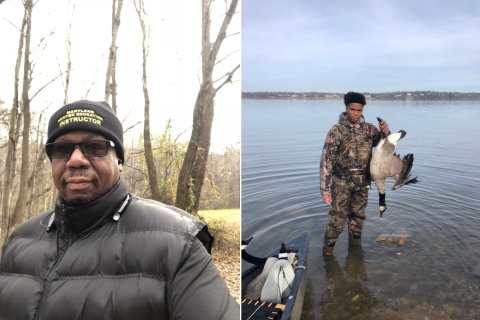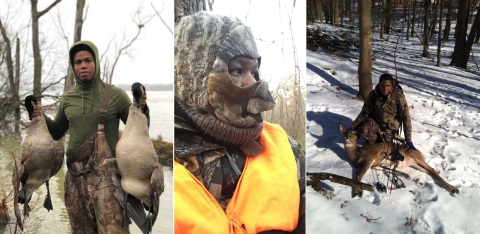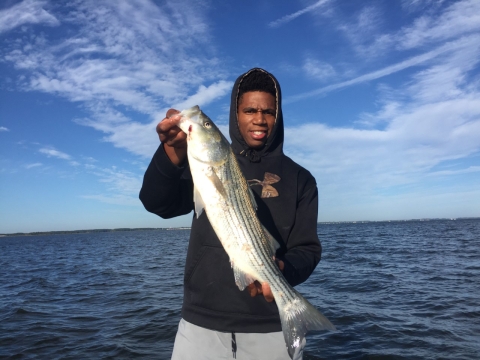Waterfowl hunting is an incredibly important part of our conservation history and an essential part of the work we do in the U.S. Fish and Wildlife Service Migratory Bird Program. We manage the Federal Duck Stamp Program, one of the most successful conservation programs ever created. Since 1934, this conservation revenue stamp, required for every waterfowl hunter, has raised more than $1 billion (yes that is billion with a “b”) in sales that has been used to conserve more than 6 million acres of wetlands. We also collect data through monitoring programs to set hunting limits for waterfowl hunters every year. As the federal leader managing waterfowl populations across the country, we work to ensure that ducks and geese can sustain healthy populations and still afford invaluable experiences to Americans who enjoy hunting.
There are an estimated 11.5 million Americans who hunt in the United States and fewer than 2.3 million waterfowl hunters. It’s estimated that 11.1 percent of the white population hunts, but fewer than 2 percent of hunters are African American, Asian or Hispanic. We spoke to an African American father and son who share a love of the outdoors and recreational hunting. Gary is an avid outdoorsman and son Javier shares that connection with his dad. We asked them a series of questions to learn about their connection to the outdoors and celebrate their stories.
1) How did you first get into hunting? Who introduced you into hunting?
Gary: I was introduced to hunting by a co-worker of mine while in college, Danny. His family was originally from West Virginia, and he inherited 400 acres of family land from his grandparents. He talked about hunting all the time and invited me to his property. I wasn’t so interested in hunting at that time, but I was an avid outdoorsman and fisherman growing up. This attraction was instilled within me from my time growing up as a former Cub Scout and Webelo (We Be Loyal Scouts). This connection, and introduction to hunting, forged a very strong friendship for us, so much so that Danny is now the godfather to my son. We are still close friends to this day.
Javier: From as long as I can remember, I’ve always loved the outdoors and nature — something about self-sustaining natural life just fascinated me and I was hooked. I first got into hunting at a young age with my father. I was 12 years old on my first hunt, and I couldn’t stop asking my dad when we would go again.
2) What do you love most about hunting?
Gary: Hunting allows me the opportunity to relax from everyday stress. I enjoy the scenery — watching wildlife undisturbed, plants and the natural patterns of nature. For me it’s not the harvest that is most important, but the calm and peace that I have. It’s almost like meditation, in my solitary moments, sitting still and quiet while in the woods.
Javier: I think what I love most about hunting is just to see the animals in relationship to each other, and their ecosystem. It beats watching Animal Planet by 10! You see the coolest things in the woods, and the more time you spend out there, the more Mother Nature shows you how awesome she is.
3) Do you know a lot of African Americans who like to hunt?
Gary: I’ve met quite a few over the years, and I’ve personally introduced even more to hunting. It’s a bond, something like a fraternity of brothers. When I became a Maryland state hunter and gun safety instructor, I was able to reach a few other African Americans with interests in hunting and conservation in general. I’ve also been a member of the Izaak Walton League of America for seven years in Maryland, where I get together with other nature lovers.
Javier: Outside of my family, I have met some good friends who also hunt and share a love for the outdoors the same as me. I still wouldn’t say it is a lot, but I do know quite a few.
4) According to the National Survey of Fishing, Hunting and Wildlife-Associated Recreation, less than 2% of African Americans in the U.S. participate in hunting, whereas an estimated 11% of Whites hunt. Why do you think that is?
Gary: I think that it’s mostly because of exposure. Most Black Americans reside within or near inner city limits: urban populated areas. At least that’s my perspective from where I live now and grew up. Most of their activities center around neighborhood clubs, centers or playgrounds, so club sports like basketball, football, baseball and soccer are where they mostly concentrate their attention. You see limited wildlife growing up in the city, and the wildlife you do see, most don’t associate with consumption. Most city dwellers have a healthy fear of wild animals and a lack of respect for their habitat at the same time.
Javier: Well, when you look at where the highest concentrated areas for African Americans, you’ll find that a lot of us are from inner cities where hunting and fishing isn’t looked at as a common activity. I think the most common introduction to hunting or fishing is through a relative or a parent. When you have generations of family coming from places like New York, Chicago, Philadelphia and Washington, DC, as a product of your environment in urban areas, I believe that odds are low of a person getting into these activities. However, I do not believe they are incapable of falling in love with it the same way I did. I know this for a fact to be true because whenever I take a friend that I met in college or high school out fishing or hunting, nine times out of 10 they are instantly hooked. It reminds me of when my dad first took me fishing and hunting; after that first time, I begged him to take me back out every chance I got. My friends do the same, regardless of where they’re from.
5) What can we at U.S. Fish and Wildlife Service do to help change that?
Gary: USFWS should produce more campaigns focused toward inner city children and teens. USFWS could also use media which depicts images of African Americans and show them that blacks are involved in hunting and fishing. Sponsor programs that will take them out on their first hunt. Present opportunities to introduce them to learning about land, plants and water, and the importance of sustainability and conservation and how it effects their own environments. You can also campaign about how healthier and more cost effective it is to harvest your own foods. Support programs that also teach wilderness survival and foraging from the land. Above all else, gun safety and proper handling. Create more shooting sports programs targeted toward Black Americans with long guns as the focus. Establish USFWS nature tours on federal properties that would simulate a hunt, where they can see wildlife and learn what to do and not to do, with the protection of an experienced guide.
Javier: First and foremost, I appreciate that you are at the U.S. Fish and Wildlife Service, and are actually asking me what I think. Thanks so much! Second, I’ve heard about the programs that you guys have started offering for inner-city kids to get outdoors like the one you did for the kids in Philadelphia at John Heinz National Wildlife Refuge [at Tinicum]. I’ve never been to that particular refuge, but I have been to Patuxent Research Refuge to go fishing, and I think that’s a great idea to reach out to them — the younger the better. Aside from my dad, I was blessed to be able to attend a great summer day camp program where the director loved to take the children fishing. We picked and ate natural organic raspberries and blackberries and endless field trips like visits to pumpkins patches and crabbing on the Chesapeake Bay. Both my dad and my summer camp director were great influences for me and have a lot to do with my appreciation for nature and the outdoors to this day. I am a believer and feel that I serve as testimony to starting kids at a young age can make all the difference.
6) What advice do you have for African Americans today to explore hunting as a recreational activity?
Gary: I would advise anyone who hasn’t had the opportunity to explore nature and wildlife to first start by taking a free hunter safety course. Ask lots of questions about any and everything involving the sport. Go out to supporting regional and federal parks and learn to scout and find wildlife signs. Bring a friend, family members or friends with you when you go.
Javier: The best advice I can give, is to just go out and try it! And tell a friend!
We hope that as you read Gary’s and Javier’s words, that by them sharing their story, it can encourage others to share theirs. We are continuing to reach out, listen, learn and take action. Help us tell the stories in an effort to celebrate the diversity of people who already love the outdoors, in order to inspire more people of all backgrounds to connect with the outdoors. From hunting to hiking to camping to birding, it’s time we ensure that all people feel welcome enjoying outdoor activities.
This story is from our Open Spaces blog.







